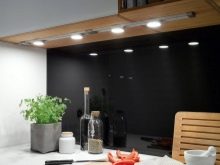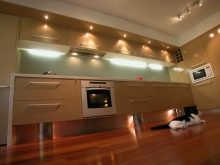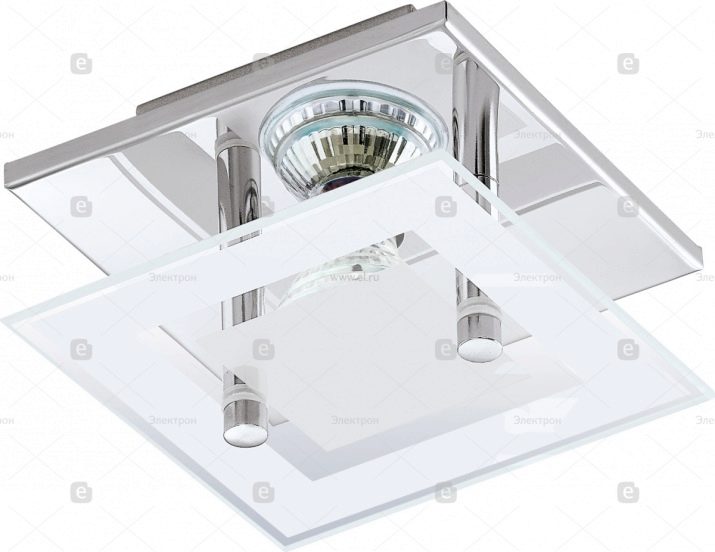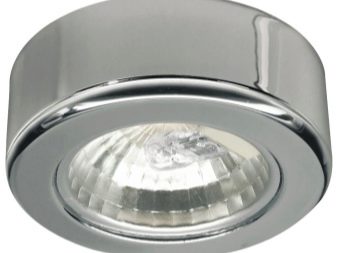Spotlights play a very important role in the interior of the room. Often they are installed in the kitchen, placing either on the ceiling, or, for example, above the work surface. But in order for the appearance of the room to please the eye and create a feeling of comfort, you need to follow some recommendations and follow the basic rules for the placement of such lighting devices. We will talk more about all the subtleties in our article.



Advantages and disadvantages
Currently, consumers, making repairs in the kitchen, increasingly prefer to abandon the usual chandelier, or in addition to it install spotlights. Their main advantage is the ability to create uniform diffused lighting. As for the traditional chandelier, in the absence of additional illumination, it creates shadows. As a result, the room visually narrows.
In addition to convenience, it should also be noted the opportunity to significantly save energy. This is because Lighting can not be switched on completely in the entire kitchen, but only in a certain area of it: above the kitchen table or above the hob during cooking.
It is also very convenient when the lamps are rotary, allowing directing the light to where the consumer considers it necessary. In this case, it is possible to emphasize the advantages of the premises or hide its shortcomings.




It should be noted the fact that Today, manufacturers offer lamps in a wide range of colors.. You can use both monochrome and color options. It will also help to create a unique and original style of the kitchen, highlight areas and focus on them.
However, it would be dishonest not to talk about the lack of such lighting fixtures. Among them, one can note the complexity of installation, since a simple chandelier is undoubtedly much easier to install.
Lamps cannot be installed spontaneously, when it comes to the complete arrangement of the kitchen, their layout is thought out at the stage of repair. In the case when the lighting points need to be built into the kitchen, this is decided at the assembly stage.


Someone may consider that such lighting is too "office". However, this reasoning is a misconception, since today you can place such devices in any apartment, giving it even more comfort and emphasizing the benefits. The main thing is not to be mistaken with design and placement.




Types, facts and tips
Spotlights can be divided into subspecies according to the installation method. Overhead, suspension and mortise models are noted.
Mortise fixtures are installed exclusively in suspended ceilings made of any material. They can hide in the ceiling itself, but can, on the contrary, act as a decorative element.


Overhead lighting devices are easily placed on an ordinary base, as they have a mounting plate for screws.


However, most often, as practice shows, consumers dwell on embedded options. I must say that they are offered on store shelves in an extremely wide range. They are made in various colors, shapes and sizes.
Spotlights are very functional. With their help, you can not only mount the main lighting, but also make certain accents at the right points, as well as use for decorative purposes. It should be borne in mind that 1 element should have no more than 2 m2 of space.


Spotlights comply with all fire safety standards. The moisture-proof material of which the housing is made allows them to be used in the kitchen, where humidity can be increased. The bulb can be located both inside and outside, respectively, the light can be made both directed and diffused.
Experienced users give some advice to those who decide to choose a spotlight for their kitchen. First of all, they note that the simpler the design, the easier it will be to take care of the fixtures, wash and clean them.
If the apartment has suspended ceilings, round models or those that have rounded corners will do. To save energy, it makes sense to install a dimmer, which is also called a dimmer.

Types of lamps
Among the lamps themselves, incandescent lamps, LED or halogen devices can be noted. I must say that LEDs are especially popular due to the efficiency, as well as the fact that they almost do not heat up. They can be used regardless of the finish, as even those materials that are flammable can be placed in close proximity to them. And it is absolutely safe, since fire is excluded. They can be either rotary, changing the direction of light, or fixed.

Incandescent lamps able to provide a bright and familiar color. However, they have flaws. They are quite large, and also burn out very quickly. In addition, they are very hot.

Halogen lamps have a long service life and economically consume electricity, but at the same time they have the most expensive purchase cost.


They should be placed in fixtures with a metal frame and ceramic cartridge, as they can heat up very much. In addition, you will need a transformer that converts the usual voltage of the home network to 220 volts to 12 volts.
Placement and rules of the "play with the light"
To place such lamps is necessary, focusing on some factors. First of all, it is necessary to take into account the dimensions of the kitchen and the height of the ceilings. If the room is small, you should consider further steps more carefully, because the main goal is to have enough light, but not too much. In addition, in such rooms, spotlights will not look bulky when compared with a conventional chandelier.
It is also necessary to remember that the style of the room should not be violated. Spotlights are presented on store shelves in a wide range, so there will be no difficulties with the choice of appliances for the kitchen, made in the style of, for example, hi-tech or modern.
It is necessary to focus on the type of ceiling. I must say that tension options have some limitations. You cannot install powerful lamps with them. 35 W halogen lamps or 60 W incandescent lamps are already banned. The material in contact with them can simply melt. In the case of plasterboard ceiling, you can choose any type of fixtures.


The chaotic placement of spotlights should not be allowed. They are specially designed in order to highlight certain zones or to focus on something, so the arrangement according to a previously thought out scheme is very important.
If we are talking about ceiling lights, they must be located at a distance of at least 30 cm from each other. The distance to the wall should be more than 20 cm. You need to calculate the number of lamps so that one piece is approximately 1.5 m2. Experts recommend doing it even easier and place 1 luminaire of 20 watts per square meter. meter of the ceiling. In the case when the power of the planned devices is more than the specified value or the main chandelier will also be in the room, the recommended number of lamps can be reduced.
If you arrange this type of lighting correctly, there is a chance to change the overall perception of space. For example, to make a small or narrow kitchen seem wider, you can place dots in the center, as well as on both sides of the ceiling. In this case, it will turn out to illuminate the room evenly and without the appearance of shadows.



As for large rooms, the task here is to create the necessary lighting primarily in all necessary areas. At the same time, the kitchen should be cozy and comfortable in general. In such a situation, a pendant chandelier is also most often used. The chandelier is usually placed in the very center of the room, and the spots are installed in the necessary working areas.
With low ceilings, the situation will be saved by rotary spotlights, from which light is sent to the ceiling. In addition, the lamps are located on the wall cabinets. In such cases, hanging chandeliers is not recommended.

We must not forget that similar lighting allows you to zone the space. You can select any of the functional areas. This is especially true in kitchen studios.
It is worth mentioning about two-level ceilings, which take on a completely different look due to spot lighting. In this situation, the choice is made in favor of recessed fixtures. You can select each level or only one of them.

See below for how to install spotlights.










